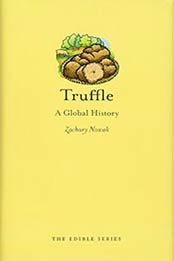
Truffle: A Global History (Edible) by Zachary Nowak
Print Length: 128 Pages
Publisher: Reaktion Books
Publication Date: May 15, 2015
Language: English
ASIN: B00T80QRY6
ISBN-10: 1780234368
ISBN-13: 978-1780234366
File Format: PDF
What is a truffle? Is it the über-shroom, the highest order of fungal foods? Does it arrive, as some cultures feel, in the moment of a thunderclap? One thing is for sure: despite its unappetizing appearance, the truffle is without a doubt one of the most prized ingredients in the world’s pantry. In this book, Zachary Nowak digs deep into the history and fame of this unlikeliest of luxury items, exploring the truffle’s intoxicating hold on our senses how its distinctive flavor has become an instant indication of haute cuisine.
Nowak traces the truffle’s journey from the kitchens of East Asia to those of Europe and the Americas. Balancing cultural, historical, and scientific perspectives, he offers a thorough and complete portrait of this many-sided mushroom. By comparing the truffle’s history in the Old World with its growing prominence in the New World, he tells a larger story of the growth and dynamism of modern Western cuisine and food cultures. Featuring many instructive and surprising illustrations, and numerous recipes both historical and contemporary, this unique and fascinating book is a must-read for chefs, food historians, and anyone ever drawn by the truffle’s mysterious, rich, and savory allure.
Nobody knows the truffles I’ve seen.
This is an informative, agreeable little book. It is excellently illustrated–some of the photos of truffles look like pebbles in fur coats. I knew little about truffles, other than having read about truffle hunters using trained pigs, and it turns out that pigs have generally been replaced by dogs, who have better noses and don’t try to eat the inventory. The first record of truffles is quite old, of desert truffles in a letter dated to about 1760 BC by the Amorite king Zimri-Lim.
There’s a little natural history–truffles are designed, so to speak, to be eaten so as to spread spores. They are part of the phenomenon of mycorrhiza that link fungus with trees in a vitally important symbiosis. The book looks at the Greeks, Romans and truffles in some detail, and then segues into Medieval and Renaissance use of truffles, mostly in France and northern Italy. The uses fit into the medical philosophy of humors, but eventually came to be seen as exotic and wonderful food. Savoy (later the Kingdom of Savoy) used truffles as gifts in diplomacy, including hunters and dogs.
While the focus is largely European, it turns out that a form of truffle has recently been found in SW China, and is now being exported. The area is one of very high biodiversity, which a truffle boom threatens (there’s a concept, a truffle boom). They are also used in criminal truffle activity, processed and passed off as much high-priced gourmet truffles. There are also American truffles, and the stories of a couple of contemporary truffle hunters (these are difficult to describe–truffle magnates? truffle businesspeople?).
The book ends with an illustrated guide to truffles and then ten or so pages of truffle recipes. This is a fun and engaging read.
![Tea: A Global History (Reaktion Books - Edible) by Helen Saberi [1861897766, Format: EPUB] 1861897766](https://cookebooks.info/wp-content/uploads/2018/11/1861897766.jpg)
![Doughnut: A Global History by Heather Delancey Hunwick [PDF: 1780234988] Doughnut: A Global History by Heather Delancey Hunwick](https://cookebooks.info/wp-content/uploads/2020/09/1780234988.jpg)
![The Homemade Chocolate Truffle Cookbook: Delicious and Easy Truffle Recipes (2nd Edition) by BookSumo Press [B07N5HZWTZ, Format: PDF] B07N5HZWTZ](https://cookebooks.info/wp-content/uploads/2019/03/B07N5HZWTZ.jpg)
![Lemon: A Global History (The Edible Series) by Toby Sonneman [1780230346, Format: EPUB] 1780230346](https://cookebooks.info/wp-content/uploads/2017/09/1780230346.jpg)
![Herbs: A Global History (Edible) by Gary Allen [1861899254, Format: PDF] 1861899254](https://cookebooks.info/wp-content/uploads/2018/01/1861899254.jpg)
![Gin: A Global History (Edible) by Lesley Jacobs Solmonson [1861899246, Format: PDF] 1861899246](https://cookebooks.info/wp-content/uploads/2018/01/1861899246.jpg)